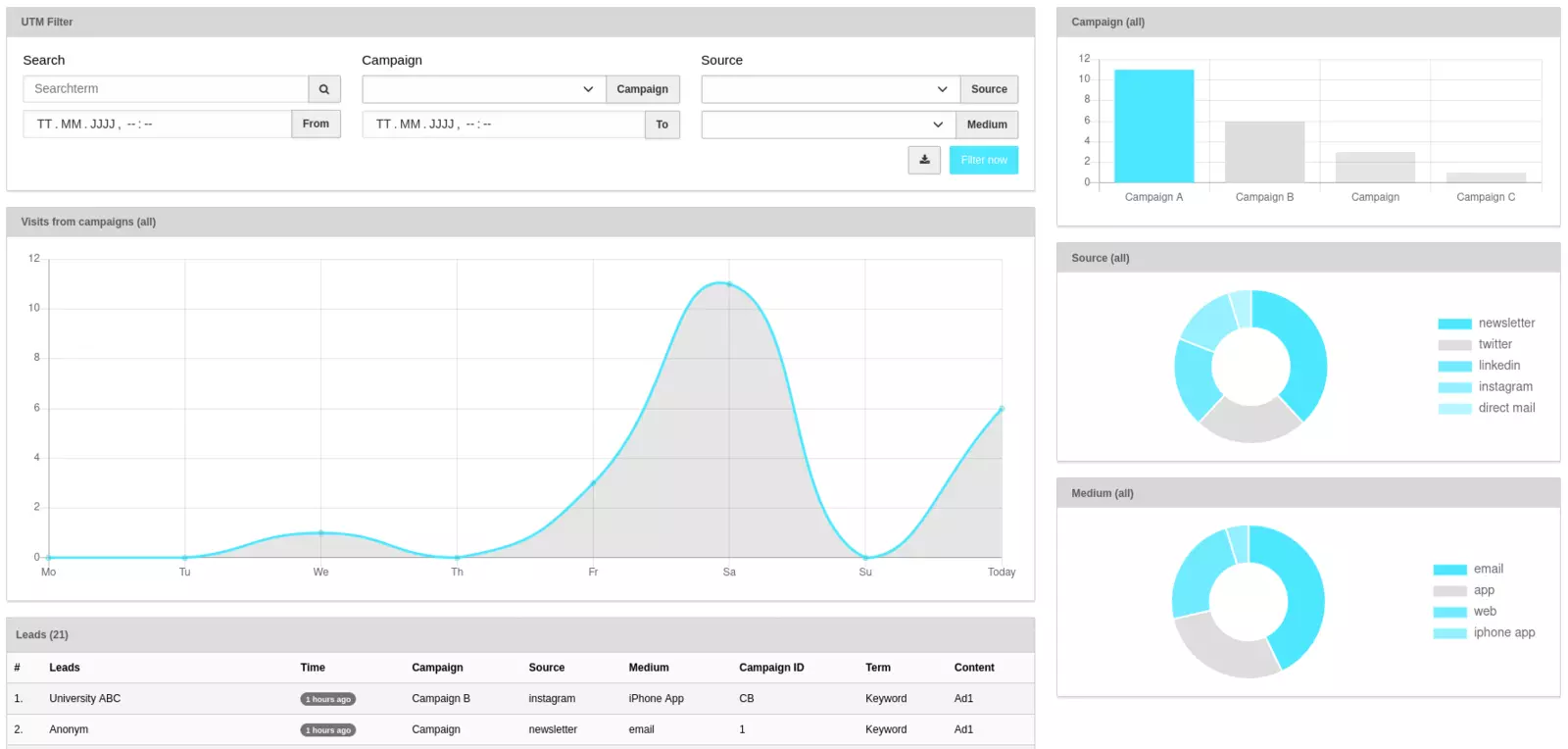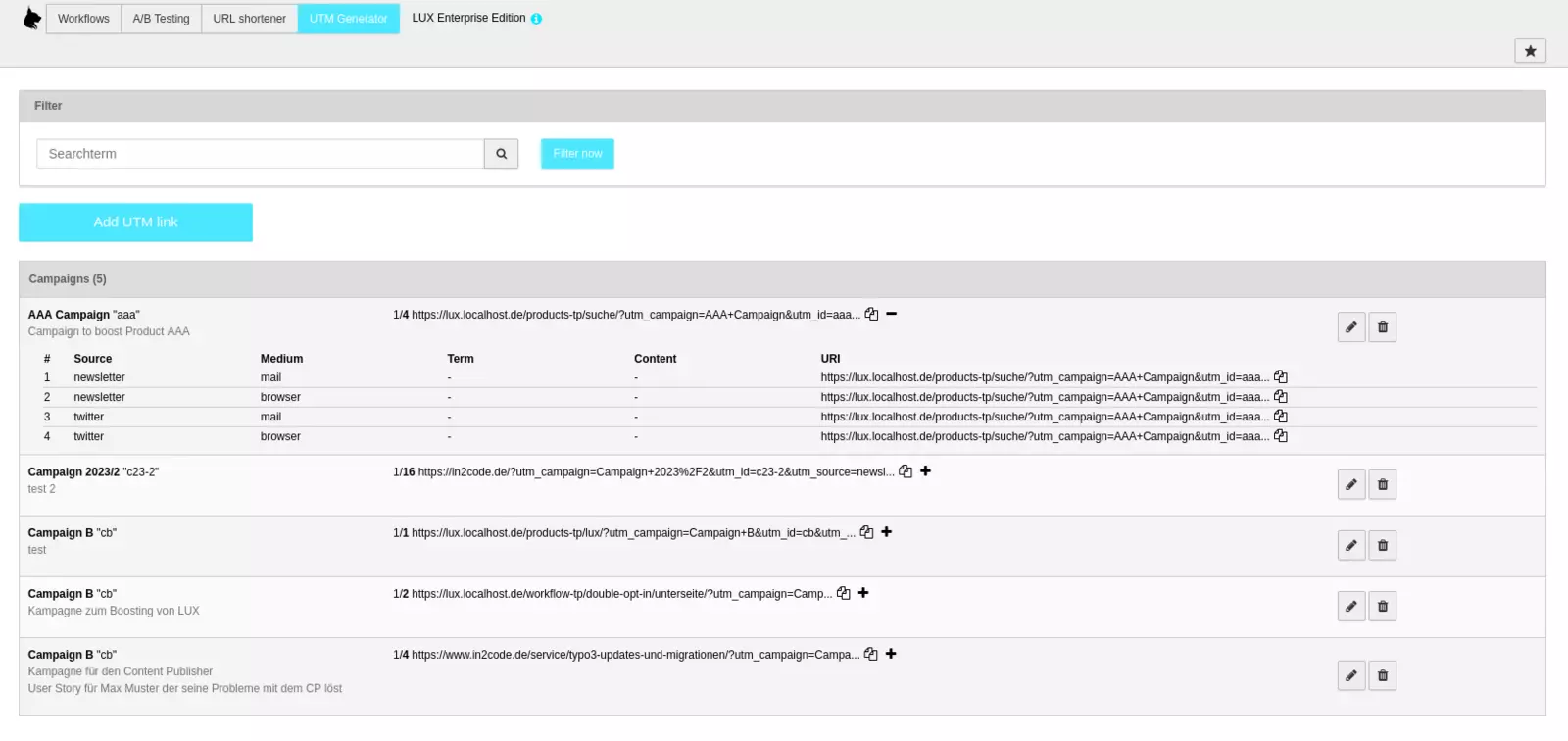1. What are UTM parameters?
The common and much-used abbreviation UTM stands for "Urchin Tracking Modules". This term was originally introduced by Urchin Software in a website visit analysis tool of the same name. UTM parameters are now widespread and online marketing is unimaginable without them. The popularity and success of this is mainly due to the fact that Google took over the company in question in 2005 and developed large parts of its software.
In the meantime, any common analysis software (Google Analytics, Matomo, etc...) or marketing automation software (LUX, Hubspot, Eloqua, etc...) can handle these parameters.
From a technical point of view, however, the UTM parameters are only so-called "GET parameters" - i.e. parameters that are visibly attached to a URL so that the software on the server can react to these parameters. In older versions of TYPO3, there were often URLs in the style of /index.php?id=123 (who remembers these URLs?). Here "id" is also one of those GET parameters that told TYPO3 which page to render. With the UTM parameters, however, there is usually no change to the content - these are only used for analysis and evaluation of the visit source. However, the representation in the URL has the same structure.
2. What can you do with UTM parameters?
As mentioned earlier, the UTM parameters are used to determine the source of the website visit. With consistent use, it can be determined whether the visitor landed on the landing page via a Google Ad (and especially via which one) or via a newsletter. Of course, any halfway mature analysis software knows approximately from which referrer (i.e. which source) a visitor comes, but this information is usually very imprecise or was concealed in advance. For example, without UTM parameters (or similar methods), there is no way to find out whether a customer clicked on a link in a personal email.
Thus, UTM parameters allow us to draw conclusions about the origin of the visit. But why is this important? In modern marketing, this is almost a naive question. Without knowing where our visitors come from, we have no way of efficiently growing and managing those sources. Put simply, the conversion rate can be improved if successful advertising measures are strengthened and, if necessary, bad advertising measures are discontinued or restructured.
In order to be able to optimize our ads and newsletters, we want to know, for example, whether our leads prefer to click on headlines, images or large, green buttons. The use of UTM parameters is also ideal for testing different advertising titles (conservative or rather aggressive?) in the online world. By the way: We have described in detail in another article how to implement A/B tests in TYPO3 in the easiest way.
With the help of the freely available community version of LUX, all types of UTM parameters can be analyzed and evaluated in a separate backend module. Targeted filtering by different terms or time periods shows the flow of visitors and the individual leads in detail.
One step ahead: As described at the beginning, UTM parameters cannot normally be used to influence page content or assets on websites. But here we have recently been breaking new ground with LUX and LUXenterprise. This information can be used specifically in the workflows to better address visitors. For example, it can make sense on the landing page to advertise other LinkedIn articles by the same author if the source of the visit was also a LinkedIn article.
3. How to generate a URL with UTM parameters?
Of course, you should provide all of your links in your campaigns with the appropriate UTM parameters. There are some tools that let you create such links and URLs. One of the best known is the Campaign URL Builder from Google Analytics. However, if you work in TYPO3, it would of course be good if such a tool were also integrated into TYPO3 in a GDPR-compliant manner. With the UTM generator, LUXenterprise offers a practical tool for generating all possible URLs with just a few clicks, which can then be easily copied and pasted into other sources. Using this generator offers you three tangible advantages:
- Automatic generation of a large number of links by simply clicking together the parameters
- Use of unique values for the same terms
- Collection of all previous UTM parameters for yourself or for colleagues
If the source is an organic LinkedIn post, a URL equipped with UTM parameters can look like this: https://typo3site.de/landingpage?utm_campaign=product-a-2023&utm_id=pa-23&utm_source=linkedin&utm_medium=linkedin_organic
There are a total of six parameters that can be used but do not necessarily have to be used. The general rule is: Use as few parameters as possible, as many as necessary. We have listed and described all the options for you:
| Parameter | Description | Example |
|---|---|---|
| utm_campaign | This parameter includes the campaign name to name a specific promotion or strategic campaign | "Campaign 2023/2" or "Summersale 22" |
| utm_id | This is the campaign identifier - similar to utm_campaign but short and unique | "c23-3" or "susa22" |
| utm_source | This is the actual source - e.g. a website, an advertiser or a publication | "newsletter" or "linkedin" |
| utm_medium | This is the marketing medium - e.g. an e-mail or an advertisement via Google Ads | "mail" or "google organic" |
| utm_term | The term and content are optional parameters that can be used individually. For example, the search term that led to the Google Ad advertising can be found here | "searchterm" |
| utm_content | If several links point to the same destination within a source, you can describe here which article or advertisement led to the destination | "add1" |
Tip: Nothing is more annoying when you accidentally use "email" and "mail" for the same source. A reasonable evaluation is almost impossible. The UTM generator in LUXenterprise is deliberately designed in such a way that parameters must be clearly named and created before the link is created in order to rule out the risk of duplication as far as possible.






